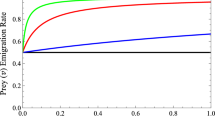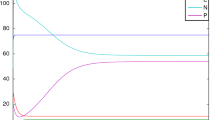Abstract
The existence of prey refuges in a predator-prey system is known to be strongly related to the ecosystem’s stability. In this study, we explored how the prey refuge distribution affects the predator-prey system. To do so, we constructed a spatial lattice model to simulate an integrative predator (wolf) - prey (rabbit) - plant (grass) relationship. When a wolf (rabbit) encountered a rabbit (grass), the wolf (rabbit) tended to move to the rabbit (grass) for foraging while the rabbit tended to escape from the wolf. These behaviors were mathematically described by the degrees of willingness for hunting (H) and escaping (E). Initially, n refuges for prey were heterogeneously distributed in the lattice space. The heterogeneity was characterized as variable A. Higher values of A equate to higher aggregation in the refuge. We investigated the mean population density for different values of H, E, and A. To simply characterize the refuge distribution effect, we built an H-E grid map containing the population density for each species. Then, we counted the number of grids, N, with a population density ≥ 0.25. Simulation results showed that an appropriate value of A positively affected prey survival while values of A were too high had a negative effect on prey survival. The results were explained by using the trade-off between the staying time of the prey in the refuge and the cluster size of the refuge.
Similar content being viewed by others

References
C. Holling, Annu. Rev. Entomol. 6, 163 (1961).
M. Venzon, A. Janssen, A. Pallini and M. W. Sabelis, Anim. Behav. 60, 369 (2000).
A. J. Lotka, J. Am. Chem. Soc. 42, 1595 (1920).
V. Volterra, Lecons sur la Théorie de la Lutte pour la Vie. Paris: Ghautier-Villars VI 214, 31 (1931).
C. S. Holling, Canad. Entomol. 91, 385 (1959).
C. S. Holling, Mem. Entomol. Soc. Can. 45, 1 (1965).
J. Martin and P. Lopez, Behav. Ecol. 10, 487 (1999).
J. J. Meyer and J. E. Byers, Ecol. Lett. 8, 160 (2005).
A. Sih, Theor. Popul. Biol. 31, 1 (1987).
S. J. Holbrook ad R. J. Schmitt, Ecology 83, 2855 (2002).
B. Mnaya, E. Wolanski and Y. Kiwango, Wetlands Ecol. Manage. 14, 359 (2006).
M. Edmunds, Defence in Animals: A Survey of Antipredator Defences (Longman, New York, 1974).
A. J. Loveridge, J. E. Hunt, F. Murindagomo and D. W. Macdonald, J. Zool. 270, 523 (2006).
M. E. Hochberg and R. D. Hold, Evol. Ecol. 9, 633 (1995).
Z. H. Ma, W. L. Li, Y. Zhao, W. L. Wang, H. Zhang and Z. Z. Li, Math. Biosci. 218, 73 (2009).
X. N. Guan, W. M. Wang and Y. L. Cai, Nonlinear Anal. Real World Appl. 12, 2385 (2011).
J. N. McNair, Theor. Popul. Biol. 29, 38 (1986).
M. W. Sabelis and O. Diekmann, Theor. Popul. Biol. 34, 169 (1988).
S. P. Ellner et al., Nature 412, 538 (2001).
S. H. Lee, Physica A 389, 259 (2010).
W. G. Wilson, A. M. Deroos and E. Mcauley, Theor. Popul. Biol. 43, 91 (1993).
A. Pekalski, Compu. Sci. Eng. 6, 62 (2004).
Y. Tao, Non. Anal.: Real World Appl. 11, 2056 (2010).
A. Ramanantoanina and C. Hui, A. Ouhinou, Ecol. Model. 222, 3524 (2011).
U. Wilensky, NetLogo. http://ccl.northwestern.edu/netlogo/. Center for Connected Learning and Computerbased Modeling, Northwestern University, Evanston, IL (1999).
A. K. Fuller and D. J. Harrison, J. Mammol. 91, 1269 (2010).
Author information
Authors and Affiliations
Corresponding author
Rights and permissions
About this article
Cite this article
Lee, SH., Kwon, O. & Song, HS. Effects of the prey refuge distribution on a predator-prey system. Journal of the Korean Physical Society 68, 821–829 (2016). https://doi.org/10.3938/jkps.68.821
Received:
Accepted:
Published:
Issue Date:
DOI: https://doi.org/10.3938/jkps.68.821



